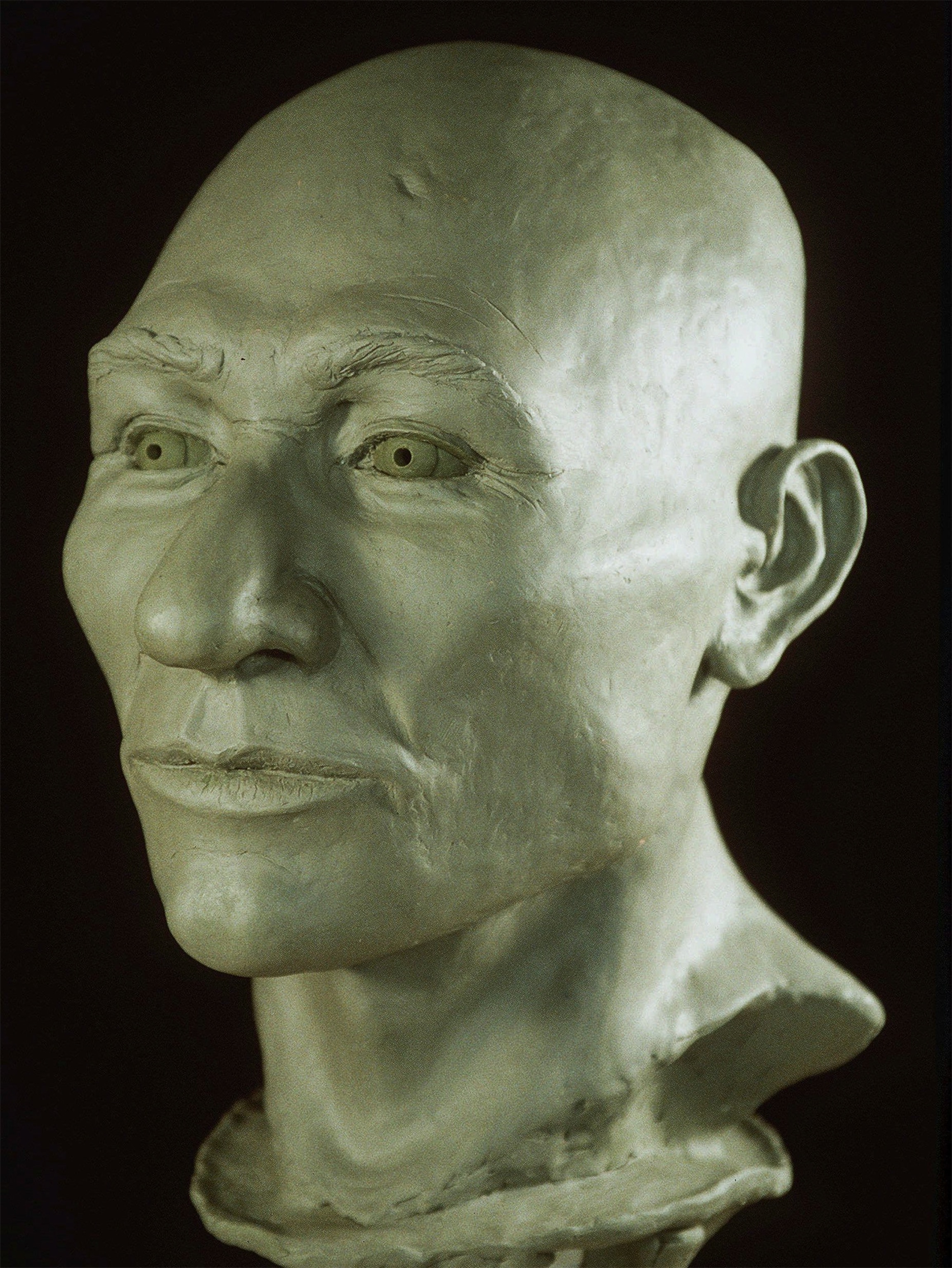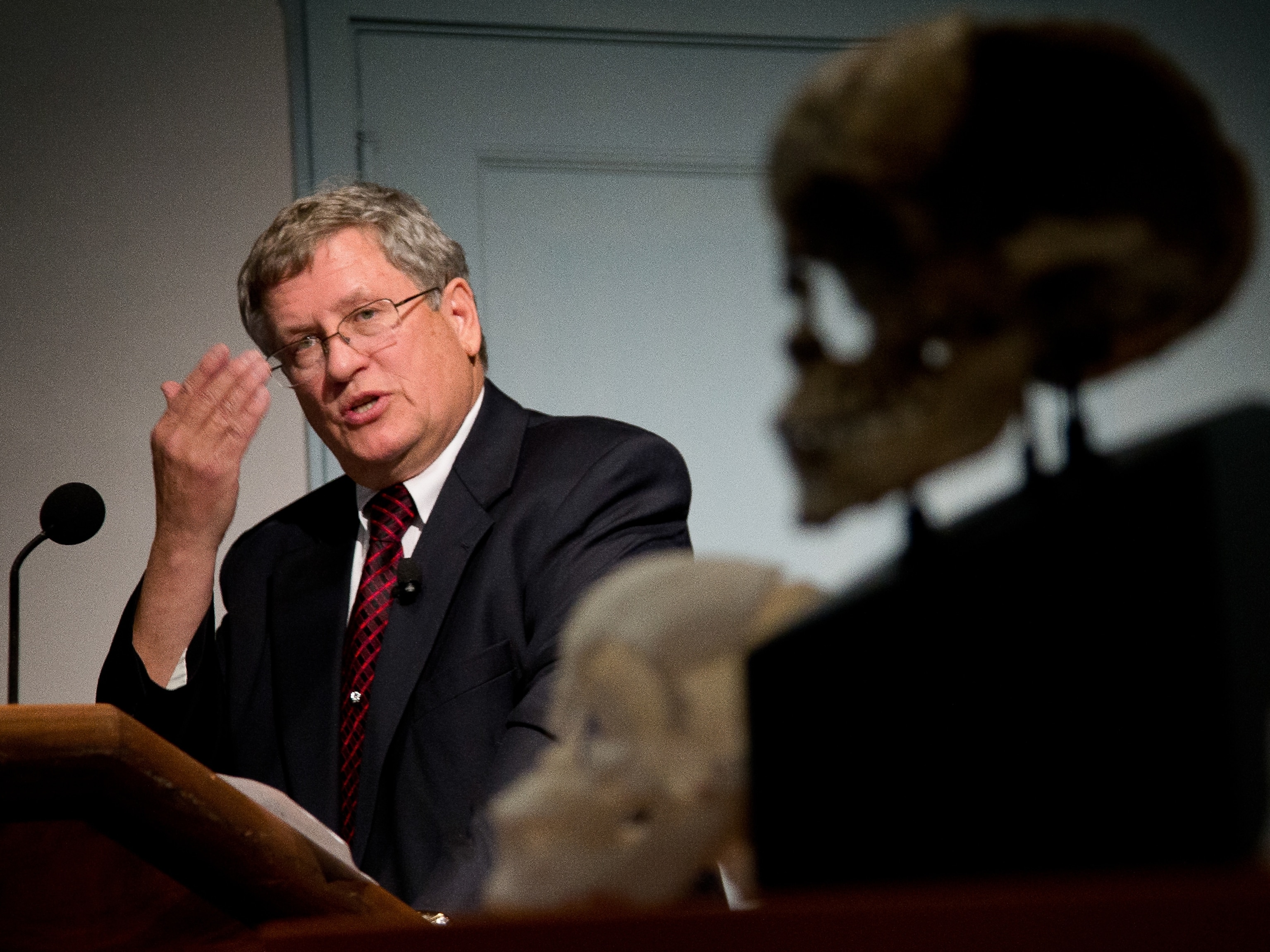
Locked Away for Years, Skeleton's Secrets Rewrite Prehistory of North America
People came to the New World thousands of years earlier and by different means of locomotion than expected, says the Sherlock Holmes of old bones.
In the summer of 1996, while wading in the shallows of the Columbia River near Kennewick, Washington, two students stumbled onto a skeleton. Dated to 7000 to 6900 B.C., it would turn out to be one of the most important archaeological discoveries ever made in North America.
But the land where the remains were found belonged to the U.S. Army Corps of Engineers. Despite repeated requests to examine the skeleton, the Corps locked the bones away. A coalition of Columbia River Basin Indian Tribes also claimed the bones.
Undeterred, Douglas Owsley, a physical anthropologist with the Smithsonian Institution, and seven other scientists filed a lawsuit. In 2002, after facing down 93 federal attorneys, the scientists won the case. And Kennewick Man's story could at last be told.
Speaking from his skeleton-packed office in Washington, D.C., Owsley, co-author of Kennewick Man: The Scientific Investigation of an Ancient American Skeleton, talks about listening to the stories skeletons have to tell, why Kennewick Man is helping rewrite the record of American prehistory, and what it's like working with the CIA and FBI on modern investigations.
Physical anthropologists use the term osteobiography, meaning "biography of the bones." Who was Kennewick Man? Where and how did he live and die?
Kennewick Man is not what I'd have expected before we began the analysis and before I'd seen him. He was found on the banks of the Columbia River in 1996. He's about five feet seven and a half. His weight is right around 161 pounds. He's very wide-bodied, very strong. Age of death is around 40.
From there we started looking at his injuries. He clearly had a pretty difficult life. He has a couple of depression fractures in the head and six different broken ribs, five of which had not healed correctly. That's a reflection of his lifestyle. He was probably on the move, and when that incident happened, he didn't have sufficient time to recover.
He also had a fracture in his shoulder joint, the type of fracture you'll sometimes see in high-end baseball pitchers, where you're throwing so hard and so fast and you fracture the posterior rim of the scapula. We can surmise from this that he was a javelin thrower, a spear thrower.
From this time period, we also know he would've often been using an atlatl. It's like an extension of the arm that allows you to throw harder, faster, farther. Most dramatically, he has a spear point embedded in his pelvis.
Was that what killed him?
No. The spear wound happened when he was a much younger adult. It would've been a hard hit, and a very fortuitous strike in terms of how it hit him. If you envision him walking down a path, you can reconstruct the downward trajectory. You can also see that the person who threw this at him is not directly in front of him but at his side at an angle of about 60 degrees. It embedded deeply in the bone, shattering the tip. But if it'd been a half-inch different orientation, it would've gone into his bowels. That would have led to an infection that would have killed him.
I found it mind-boggling that you could discover through the chemical signature locked in the bones what this prehistoric man was eating and drinking. Talk about how you extract that information.
Most people are not aware of the types of information that you can collect from the human skeleton. You start at the very basics with an inventory of what you have. Then the age, sex, and ancestry. From there you can get into the details of his health, his pathology.
Kennewick Man's bone chemistry tells us that he's not from that area. The drinking water he grew up on is not drinking water of the type you'd get out of the Columbia River. He's not from Oregon or the state of Washington. He comes from much farther north. He's a long-distance traveler and a hunter.
We can also determine what his diet was. You are what you eat. And one thing is very clear, he did not grow up on the types of game you see in the Columbia River Basin, like deer or elk or rabbits. He's a marine mammal hunter. This guy is eating seals. Lots and lots of seals. That's what his bone chemistry tells us. And that just surprised the socks off me.
So was he what we would today call an Inuit?
This is way before there were Inuit. But there are parallels in terms of the diet. In the final chapter of this volume, we look at his origin. He's certainly of Asian origin. His roots are going to be East Asian maritime hunter-gatherers dependent on seals. To get isotope values like you see in him, you at least have to get into coastal central Alaska or even more to the west. His facial features tie him strongly, in terms of the shape of the skull, with East Asian groups like the Ainu of ancient Japan, or Polynesians.

I gather you have a model of him on your desk. Tell us about the facial reconstruction you did of Kennewick Man.
[Laughs] He's right behind me-I can reach around and touch him. I've been doing forensic missing persons casework since 1978. Over the years I've worked with a number of artists on facial reconstructions. We use them on missing persons cases, where nobody fits the description. You'll try to capture a likeness that you can show on a poster or television.
In this instance we worked with two forensic artists and my colleague, Karin Bruwelheide. We had the bones defining the template-the relationship of the eyes to the nose to the mouth. Those are pretty set features. You're dealing with somebody with a very lean musculature. This guy is outdoors every day. He's going to show signs of age and weathering.
We also turned to historic photographs of groups like the Ainu and historic Polynesian photographs to look at subtle features like how the eyes and nose are. We then brought all that together. The final face looks pretty cleaned up and ready to go to church. He probably had a much more austere appearance. But I have very high regard for this man, and I wanted to put his best foot forward.
How has Kennewick Man changed our understanding of the way the Americas were peopled? Tell us about the kelp highway.
I think we're coming to realize that people got into the New World thousands of years earlier than what we'd anticipated and by different means of locomotion than we'd expected. I don't doubt people were going back and forth across the Bering land bridge.
But people of this time period also knew about boats, probably made of skin. If you were following the coastline in this time period, there would have been places where glaciers would have projected out into the ocean. So you'd have to either walk over them, which would've been difficult, or skirt around them using boats.
I think there were no boundaries. You have people following along the coastline. There is also good evidence there are not just people coming in at this time period from the Pacific side, of which Kennewick Man is a representative. My colleague Dennis Stanford has been finding more and more evidence that indicates that people got into the New World on the Atlantic side across the pack ice from Spain and France 17,000 to 20,000 years ago.

In addition to scholarly work of this sort, you've helped identify human remains for the CIA and FBI. Tell us about some of the cases you're working on right now.
I work on all different types of time periods. I go across centuries, searching for answers that the bones can tell you, or that you can't find in history books. A lot of my studies deal with Civil War-era remains. I've also analyzed skeletons from Jamestown from the 17th century.
I also do a lot of human identification casework for law enforcement agencies. I assisted with the Pentagon plane crash victims [after 9/11] and the Branch Davidian compound [in Waco, Texas]. I worked on Jeffrey Dahmer's first victim. These are usually cases where you can't use traditional criteria to identify the person. You're looking at burned remains or badly decomposed remains. The main question is establishing positive identification and providing information on the cause of death.
A case I am reviewing right now is a man who disappeared who has skull trauma. I also have a case of a woman whose remains were unearthed. I write reports for law enforcement that help establish basic questions on what happened to this person and who they are. We're basically speaking for the individuals who can't speak for themselves.

There's a great line in the book where you say that Kennewick Man was whispering to you. What was he whispering?
Each skeleton I work on has a story. I see myself very much as a storyteller, discovering people's lives and circumstances that those bones are telling me. I've literally worked on thousands of skeletons, but I've never seen a skeleton that was so willing and so informative in terms of talking about his life. He came out of the ground, and he's telling us about what life was like at a time period we can only barely imagine.
And I hope the story won't end with the book. In the concluding chapter, I lay out four key studies I think need to be done to add additional information. For one thing, that projectile point. We were never able to get the Corps of Engineers to allow us to do a proper study, even though it would have been a nondestructive test. We would really like to determine what kind of stone the projectile was made of. You can then take it back and try to identify the quarry where it originally came from. That would, in turn, tell you the origins of the person who threw the spear. Was he local, and Kennewick Man had stumbled into his territory? Was he wounded by friendly fire during a hunting expedition?
We also want to get hold of a tooth. You could look at his isotope values and learn more about his early origins. It's not that I feel I need to be the one to do that. The group of eight scientists I worked with has opened the door for other scientists and scholars. So I would like to encourage other people in my field to request permission to look at these bones to add to our knowledge of Kennewick Man.
Do you think you'll have to go back to court?
[Laughs] I hope not. I would never rule out anything. But I hope we're past that.
Simon Worrall curates Book Talk. Follow him on Twitter or at simonworrallauthor.com.







